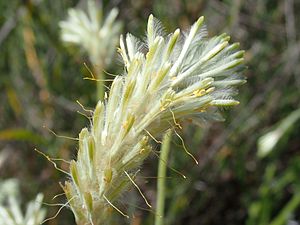Ptilotus polystachyus facts for kids
Quick facts for kids Ptilotus polystachyus |
|
|---|---|
 |
|
| Scientific classification | |
| Synonyms | |
|
Ptilotus alopecuroideus (Lindl.) F.Muell. |
The Ptilotus polystachyus is a unique plant. It is often called the Prince of Wales feather because of its feathery flowers. This plant looks a bit like grass. It belongs to the Amaranthaceae family, which includes many different kinds of flowering plants.
Where It Grows
The Prince of Wales feather plant is native to Australia. This means it naturally grows there and nowhere else. You can find it in almost all the main states of Australia. The only state where it does not grow is Victoria.
How It Got Its Name
Scientists give every plant a special two-part name. This helps everyone know exactly which plant they are talking about. The Ptilotus polystachyus was first described in 1829. A scientist named Charles Gaudichaud-Beaupré gave it the name Trichinium polystachyum back then.
Later, in 1868, another scientist named Ferdinand von Mueller studied the plant again. He decided it fit better into a different group of plants. So, he changed its name to Ptilotus polystachyus. This new name placed it in the Ptilotus group, which is how we know it today.

